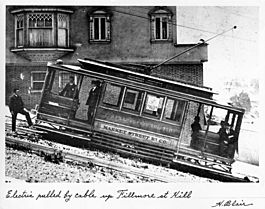Fillmore Counterbalance facts for kids
Quick facts for kids Fillmore Counterbalance |
|
|---|---|
 |
|
| Overview | |
| Other name(s) | Fillmore-Street Line |
| Locale | San Francisco, California |
| Service | |
| Operator(s) | Market Street Railway/United Railroads |
| History | |
| Opened | 5 August 1895 |
| Closed | 5 April 1941 |
| Technical | |
| Track length |
|
| Number of tracks | 2 |
| Character | Combination electric & funicular streetcar |
The Fillmore Counterbalance was a special kind of streetcar line in San Francisco. It helped streetcars climb a very steep part of Fillmore Street. Operated by the Market Street Railway (MSRy), it ran from 1895 to 1941.
What made it unique was how it worked. While most streetcars used electricity, the Fillmore Counterbalance also used a mechanical cable system. This system helped the streetcars go up and down the very steep hills. It was an important part of the city's 22 Fillmore streetcar line.
Contents
How the Counterbalance Worked
The Counterbalance line ran along Fillmore Street from Broadway, which was at the top of a hill, north to Bay Street. The steepest parts of this route had very sharp slopes, ranging from about 14% to 25%. Imagine trying to walk up a hill that steep!
For two blocks, between Broadway and Green Street, the Counterbalance used a special underground cable. This cable was like a continuous loop. It helped cars going downhill assist cars going uphill. The weight of a descending car would help pull an ascending car up the slope.
Cable System Details
The underground cable looped around two large wheels called sheaves. These sheaves were hidden in brick rooms under Fillmore Street. One was near Broadway, and the other was near Green Street. A special brake at the Broadway sheave helped control the speed of the cars.
Streetcars would attach to the cable using a strong bolt. This bolt connected to a special "plow"-shaped part on the car. When a car reached the end of the cable line, it would unhook. Then, its own electric motors would take over to carry it the rest of the way.
It was very important for cars to be attached to the cable on the downhill sections. If a car wasn't attached, its brakes alone couldn't stop it on such a steep slope. The wheels would just slide! A special track switch at Green Street allowed cars to move between the uphill and downhill tracks.
The streetcars used on this line were the smallest in San Francisco. They were called "dinkies" and were built by the Hammond Car Company.
A Look Back at History
The Market Street Railway (MSRy) announced its plan for the Counterbalance in May 1895. They wanted to extend their electric streetcar line over the steep hill using this new cable system.
The first tests with two cars happened on August 5, 1895. They were a "perfect success." Soon after, MSRy added special hooks to their other streetcars. This allowed more cars to use the Counterbalance all the way to Bay Street.
In 1902, MSRy joined with other companies to form the United Railroads of San Francisco (URR). At this time, the Counterbalance line was changed. Special Counterbalance cars only worked north of Broadway. Regular streetcars handled the route south of Broadway.
In 1912, there was a suggestion to build a tunnel under Fillmore Street. This was to handle more passengers for the 1915 Panama–Pacific International Exposition. However, the tunnel plan was later canceled in 1913.
Instead, URR improved fourteen of the "dinky" streetcars. They enclosed the open car bodies and added air brakes. They also installed controls that allowed two cars to run together as a train. This helped carry more people. The cable system was also upgraded to handle the heavier two-car trains. These changes increased the number of passengers the line could carry each hour.
The Fillmore Counterbalance ran its last day on April 5, 1941. A few years later, in 1944, the Muni took over MSRy. Muni later changed the streetcar route to a trolleybus service in 1949. This trolleybus line, the 22 Fillmore, is still running today!
Incidents on the Line
Like any transportation system, the Fillmore Counterbalance had its share of incidents. These events helped engineers learn and improve safety.
On December 23, 1901, a streetcar slid down the hill without warning. It crashed into another car and then a telegraph pole. Thankfully, many passengers were able to escape before the collision. Investigations helped understand what happened and how to prevent similar events.
Other incidents occurred over the years. In 1907, an ascending car detached from the cable, causing descending cars to speed downhill. In 1914, a brake failure led to another downhill plunge. In 1915, a descending car received a signal to release the cable too early. This caused an ascending train to roll backward and hit another train. Conductors tried to help passengers get to safety.
Even a house was affected in 1921 when a runaway car left the tracks and hit a building. These incidents, while serious, often led to improvements in the system's design and operation.
Images for kids



